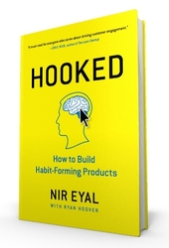Are you addicted to your web apps? You may be – and that’s not necessarily a bad thing! This week UX Booth had the opportunity to read Hooked: How to Build Habit-Forming Products, Nir Eyal’s new book about habit-forming products, and we are… well, hooked. We’re excited to share with you our review of “Hooked” – and at the end of the article, see how to win a free copy!
We’ve all sat down to view “just one” Reddit/Facebook/Pinterest post more, and glanced up to find the hours gone. We’ve all shared the surge of joy from finding an adorable puppy video or perfectly fitting meme. We’ve also felt the satisfaction that comes when Google Now reminds us to leave for an appointment we’d forgotten was scheduled, and the odd pride when Siri correctly understand our words and finds the perfect Thai restaurant for dinner.

Nir Eyal covers these sensations and more in his new book, “Hooked”, as he explores the creation process behind the habit-forming products that alternately enhance and infest our lives. Much like the zombies overrunning films and television shows, Eyal explains, addictive products are taking over – but like the human heroes we watch, we are the survivors, and we hold the power. But the key differentiator between zombies and products is that we are building the products. In “Hooked,” Eyal breaks down how we can design habit-forming products, what makes them so addictive, and perhaps most importantly, how we can use this power for good.
Moral manipulation
What makes “Hooked” particularly interesting is this last item: how we use our power of manipulation. Eyal is tackling an area of UX that is at once philosophical and topical. We’ve written our fair share of articles on ethics, morality, and the philosophies behind creating positive, engaging experiences here on UX Booth, and we’ve come to the conclusion that there is no one right answer, but that we must keep learning, keep questioning.
This is the grey area that every UX designer grapples with. As a designer working for an organization, we have a responsibility to increase the ROI, whether that means making a checkout experience intuitive enough that users will make a purchase, or subtly convincing them they want—or need—the product we’ve built. We also have a responsibility to the user, however. We are responsible for ensuring that our user journeys result in positive experiences, and that we are encouraging users to do not only what is good for our organizations, but also for themselves.
Eyal explores this morality issue through the lens of both the business and the user. He knows that the business seeks out profitable opportunities, and he provides readers with valuable tips for creating engaging products. However, given that a good “hook” convinces the user he needs more and more of the product, an ethical business can’t create just any engaging product—and Eyal has sought out examples where the users’ lives are genuinely improved by the products they get hooked on. Any designer reading “Hooked” would do well to pay attention to that detail throughout the book, and consider the ethics behind choosing a product to create: does it actually help the user? Does it solve for the user’s needs?
When harnessed correctly, technology can enhance lives through healthful behaviors that improve our relationships, make us smarter, and increase productivity.
-Nir Eyal, Hooked: How to Build Habit-Forming Products
The morality of our actions becomes a more and more pressing issue as we design programs that learn from user interactions and heavily impact our users’ lives. We are building a world in which humans and devices collaborate, and we need to take responsibility for that. Are we building a world we can be proud of? Are we building an environment where people will benefit from the devices they rely on? The likelihood is high, so long as practitioners such as Eyal continue to raise important questions and explore this uncharted territory.
Get hooked
It’s clear that “Hooked” could be read and used by UX professionals in a variety of ways; like so many UX guides, it offers both entertaining stories and useful how-tos. As such, there’s no one right way to approach the book. Here are a few options for getting into “Hooked”:
- Read it like a novel. Cover to cover, Eyal has written an engaging and enjoyable book (and not just for the zombie references).
- Scan it. Skimmed, “Hooked” provides quick tips by way of the “Remember and Share” section at the end of each chapter.
- Skip around. Read in bits and pieces, each individual chapter stands alone, as a deeper dive into the triggers, actions, rewards, and investments required to truly hook a user.
I recommend starting off by skimming, and then reading the chapters as time allows, to better understand the takeaways presented.
We’re offering our readers the chance to win a free copy of “Hooked!” Just visit the “Hooked” landing page, and enter your email for a chance to win one of 10 copies. “Hooked” is also available for purchase online, and don’t forget to let us know what you think in the comments below.